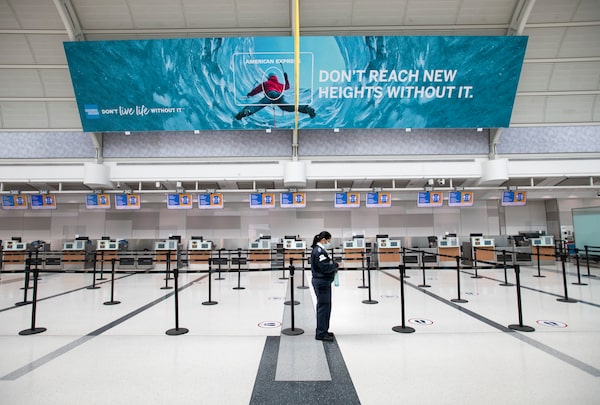
A worker stops to check their mobile device in departures area of Terminal 3 around noon at Toronto Pearson International Airport on July 14 2020.Fred Lum/The Globe and Mail
Toronto’s Pearson International Airport has announced it is cutting 500 positions after months of declining air travel and passenger traffic.
The Greater Toronto Airports Authority (GTAA), which operates Pearson, said that the coronavirus pandemic has reduced the airport’s passenger numbers to 1996 operating levels and that traveller numbers in April decreased by 97 per cent compared with 2019.
Pearson says it doesn’t expect that business will return to pre-COVID-19 levels for at least three to five years.
The cuts will reduce the airport’s total work force by 27 per cent. Two hundred of the 500 positions being cut are unfilled positions, while the remaining 300 jobs will be a combination of voluntary departures and layoffs. The cuts are effective immediately and departures will continue into the fall, according to a press release by Pearson Airport. All employees will be offered employee assistance program support in addition to notice and severance packages.
“This is an extremely difficult time for the aviation industry and it’s not possible to predict how air travel will recover,” Tori Gass, a GTAA spokeswoman told The Globe and Mail. As such, Ms. Gass said, the elimination of these positions are considered permanent.
Antonios Kourteridis, GTAA’s district chairperson for Unifor, Canada’s largest private-sector union, said that the cuts were “very unfortunate,” but that the union has built a strong relationship with the airport and that they are committed to working together through the difficult time.
“It’s amazing how you get used to bad news, right?” he said.
In the first three months of 2020, Pearson’s total revenue was $339.1-million, compared with $362.4-million in the same period last year, according to the airport’s latest financial report.
The airport says that prior to the cuts, it had taken cost-reduction measures to mitigate the effects of lockdown and air travel restrictions, including a hiring freeze, reduced planned spending, temporary reduction of executive salaries, and use of the Canada Emergency Wage Subsidy and the Canada Emergency Commercial Rent Assistance programs.
Pointing to these efforts, Steven Tufts, a spokesman for the Toronto Airport Workers’ Council (TAWC), a collective that represents Pearson’s employees, union and non-union, said that overall, the GTAA has taken the right path for its layoffs strategy, opting to look at ways to keep people employed for as long as possible.
Other airports, such as Vancouver International Airport and Calgary International Airport, have also laid off substantial numbers of their staff in recent weeks and months. Calgary Airport Authority laid off one-third of its work force in late March and in May, and the Vancouver Airport Authority cut a quarter of its employees, both citing the same reasons as Pearson.
The TAWC is now waiting to hear more specifics of which roles will be eliminated, Mr. Tufts said, adding he hopes the burden won’t fall entirely on front-line workers, many of whom are essential in maintaining a safe and clean environment as things reopen.
“It’s a question of sharing the pain across unionized workers, front-line workers and senior-level management,” he said.
Despite the current crisis, Mr. Tufts said he and his group are trying to think about how to rebuild the airport once things begin to return to normalcy, including considering how they can retain workers and possibly bring back laid-off employees once air travel demand returns.
“It’s very difficult to look at what a new building might look like when you’re inside one that’s burning down,” he said. “But that’s exactly what has to happen right now.”
Your time is valuable. Have the Top Business Headlines newsletter conveniently delivered to your inbox in the morning or evening. Sign up today.